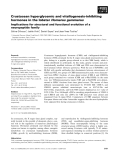
European family structures
-
(bq) part 2 "consumer behaviour - a european perspective" has contents: groups and social media; european family structures, household decision making and age cohorts; income and social class, culture and consumer behaviour, cultural change processes, consumption and european consumers.
 326p
326p  bautroibinhyen27
bautroibinhyen27
 11-05-2017
11-05-2017
 38
38
 3
3
 Download
Download
-
(bq) part 2 book "consumer behaviour - a european perspective" has contents: attitudes, individual decision making, groups and social media, european family structures, household decision making and age cohorts, income and social class, culture and consumer behaviour, cultural change processes, consumption and cultural differences.
 382p
382p  bautroibinhyen23
bautroibinhyen23
 02-04-2017
02-04-2017
 41
41
 3
3
 Download
Download
-
Crustacean hyperglycemic hormone (CHH) and vitellogenesis-inhibiting hormone (VIH), produced by the X organ–sinus gland neurosecretory com-plex, belong to a peptide group referred to as the CHH family, which is widely distributed in arthropods. In this study, genetic variants and post-translationally modified isoforms of CHH and VIH were characterized in the European lobster Homarus gammarus.
 10p
10p  inspiron33
inspiron33
 26-03-2013
26-03-2013
 50
50
 3
3
 Download
Download
-
The differences in family structures are also confirmed by household statistics. Whereas single households have by now become the most frequent household size in some European agglomerations, they continue to be the exception in Mexico: Single households make up only 1.5% of all households in the 2000 population census (compared to 1.0% in 1990). While two thirds of all households consist of couples with or without children (or one parent with children), roughly one third of households include more persons (e.g. grandparents, other relatives etc; see Table 5).
 16p
16p  nhacchovina
nhacchovina
 22-03-2013
22-03-2013
 46
46
 4
4
 Download
Download
-
This is a dynamic process was first observed in post-industrial European societies in the nineteenth century. The United Nations Conference of Ageing Populations in the context of the family held in Japan in1994 observed that all developed countries at least one demographic issue in common: population aging which was the inevitable consequence of fertility decline. But although fertility decline is usually the driving force behind changing population age structures, changes in mortality assume greater importance as countries reach lower levels of fertility.
 257p
257p  ut_hai_can
ut_hai_can
 26-12-2012
26-12-2012
 40
40
 7
7
 Download
Download
CHỦ ĐỀ BẠN MUỐN TÌM


















